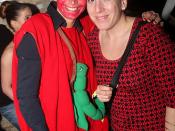There is no doubt that Tanizaki JunÃÂichiro (1886-1965) is one of the most prominent Japanese writers. He had won every major Japanese literary prize and received from the emperor the Order of Culture, the highest honor the government can bestow on an artist. The Reed Cutter is published at late 1932, and is one of Tanizaki ÃÂs most famous narrative. The splendid setting and the multiple layer of the narrative made The Reed Cutter a truly masterpiece. In the following essay, numerous narrative strategies and techniques were being discussed. Which work as a guide in order to achieve a betting understanding of TanizakiÃÂs art of storytelling.
The narrative opening with a splendid setting in a place called Yamazaki. A gorgeous place near the intersection of three province, Yamashiro, Kawachi and Settsu. The setting of The Reed Cutter draws the reader attention away from our everyday world. A place where ÃÂeven today the thatched houses lining the road on both sides look terribly antiquated to an eye that is accustomed to the Westernized towns and villages along the Hankyu LineÃÂ .
The primary narrator of the narrative is a man from Tokyo, he is a very knowledgeable man with antiquarian taste. His presentation of speech is lyrical and he often provide poems or texts as a sources of information about the region. Not only these poems and texts provide generally background information for the readers, but also generate impressive mood for the setting of the narrative. For instance, the narrator used a fourteenth-century historical narrative The Larger Mirror ( Masukagami ) to describe the magnificent Minase Palace :ÃÂSpring haze at the base of the mountain veils Minase River, Whatever made me think that evenings are best in fall ?ÃÂ .
The primary narrator also have analytical views of things. He used the text The Larger Mirror as a source of information to analyze the position of the Palace :ÃÂForm here the great Yodo River was visible, and the Minase flowing into it. All at one the strategic position of the detached palace came clear to me. The palace must have faced on the Yodo to the south and on the Minase to the east, and embraced a magnificent graden of many acres in the corner of land formed by their confluence. In that case, yes, the Retired Emperor could have come down by boat from Fushimi and moored below the balustrade of the angling pavilion, and he could have traveled freely between here and the capital. This is consistent with the text of The Larger mirror, which says that His Majesty came to spend much of his time at Minase Palace.ÃÂAlthough the primary narrator is from Tokyo, he is familiar with the geography and history of the area. He often provide detail information about the area :ÃÂThe Yamashiro Plain around Kyoto to the east and the plain of Settsu, Kawachi, and Izumi provinces around Osaka to the west contracted here to a narrow passage, with a single great river flowing through it. Thus Kyoto and Osaka are linked by the Yodo River, but their climates and cultures differ, and this spot is the dividing line.ÃÂAs the narrator is pleasuring from his wine and the dreamy atmosphere, a man suddenly appear. The friendly old man begins to sing and drink with the primary narrator. The man begins to tell story about his father and Lady Oyu. The focus of the narrative shifts gradually from the primary narrator to him, which is the secondary narrator.
The secondary narrator appeared to be the son of Seribashi. When the secondary narrator was young, his father took him to moon-viewing on Lake Ogura every year during the Fifteenth Night festival. They gaze though the hedge of a rich man villa every time. The lady in the villa is Lady Oyu. Lady Oyu was a very attractive, innocent and childlike woman. She married into the Kayukawa family, but four or five years later her husband died. She became a widow at the age of twenty-one or twenty-two. Seribashi is deeply attracted by Lady Oyu, and wanted Lady Oyu to become her wife. However, since Lady Oyu had a son by her late husband, and the customs would not let Lady Oyu to remarry. Seribashi decided to marry Lady Oyu ÃÂs sister, Oshizu. Seribashi married Oshizu because he wanted to become the brother-in-law of Lady Oyu and therefore, he will became closer to Lady Oyu. On the wedding night, Oshizu confessed she marry Seribashi because she knew that Lady Oyu was also secretly in love with Seribashi. Oshizu wanted Oyu to be happy, so she devoted herself to marry Seribashi just in name only. Thereafter, Oshizu did her best to bring Oyu and Seribashi together, when three of them are together, Oshizu will use various trick to urge Oyu and Seribashi toward greater relationship. Later, Oshizu confessed to Lady Oyu that she and Seribashi have never consummated their marriage. At first Lady Oyu were more reserved than before, but soon after the relationship between Lady Oyu and Seribashi became very intimate.
Unfortunately, three or four years later, Lady Oyu ÃÂs child, Hjime, died of pneumonia. Soon after, Lady Oyu ÃÂs frequent visit became a subject of comment. There were many rumors about their relationship, therefore, Lady Oyu ÃÂs brother and the Kayukawa family suggested Lady Oyu to remarry. A sake maker called Miyazu proposed to marry Lady Oyu and suggested to live in his villa together on Lake Ogura. Lady OyuÃÂs brother and the Kayukawa family urged her to get marry. As first, Seribashi wanted to commit suicide with Lady Oyu. But Seribashi loved her so much and he didnÃÂt want Lady Oyu to die. Therefore, he asked Lady Oyu to marry Miyazu. And so Miss Oyu was soon remarried to Miyazu. However, Miyazu was a playboy and married Lady Oyu on a whim. He tired of Lady Oyu almost immediately and hardly ever went near her villa again. On the other hand, Lady Oyu ÃÂa family and Seribashi family went into decline from that time on. The secondary narrator concluded his story by telling that he was the son of Oshizu and soon he disappeared.
The present of the secondary narrator is very important to the narrative. As the focus of the narrative shifts gradually from the primary narrator to the secondary narrator, the primary narrator became the narratee of the secondary narrator. The secondary narrator ÃÂs central position as primary narratorÃÂs and reader ÃÂs only source of information on Seribashi and Lady Oyu is crucial to the narrative. The secondary narrator also acted as a participant and character in their story. Since the story of Seribashi and Lady Oyu was told by the secondary narrator, the audience sees the story through the filter of narrator ÃÂs account. As an audience, there is no choice but to accept what he said was true. Although the secondary narrator used ÃÂIÃÂ to tell the primary narrator the narrative, he often uses third person perspective when describing the characters :ÃÂIt was Miss Oyu ÃÂs nature to make everyone who came near her feel this way, including her parents, sisters, and friends. When my aunt visited Miss Oyu as a girl, Miss Oyu was treated as though she were Kosobe family treasure. She never did the smallest chore herself, and her sisters looked after her like chambermaids;ÃÂLady Oyu is another very important character of the story. Lady Oyu is portrayed as an innocent, charming and childlike woman who takes for granted luxury and devotion of those around her:ÃÂ Being a ÃÂperson of character,ÃÂ to borrow my auntÃÂs words, Miss Oyu didnÃÂt ask people to treat her this way, nor was she arrogant or pushy, but everyone was extremely kind to her, waiting on her as if she were a princess and allowing her to do as she leased, determined not to let her suffer the slightest anxiety. They sought ot keep her untouched by the everyday troubles of the world, even if it meant sacrificing themselves for her sake. It was Miss OyuÃÂs nature to make everyone who came near her feel this way, including her parents, sisters, and friends.ÃÂLady Oyu was also born with a theatrical gift :ÃÂ her thoughts and gestures were spontaneously theatrical, which enhanced her cheerful personality and added to her charm without ever seeming artificial or affected; and the greatest different between Oshizu and Lady Oyu was that Oshizu lacked this sense of theater.ÃÂThe reason that Lady Oyu is portrayed this way is because the author wanted the reader to make a distinction between Oshizu and Lady Oyu. Thus, it provided a convincing reason why Seribashi is deeply in love with Lady Oyu but not Oshizu. The author also used indirect techniques to strengthen the image of Lady Oyu. Lady Oyu is described as willful, Oshizu is considerate; Oyu is unplanned, Oshizu is scheming; Oyu takes others devotion as granted, Oshizu is unquestioningly devoted to Oyu. These differences makes Lady Oyu a character with unique characteristic.
The image of Lady Oyu portrayed by Seribashi provided psychological effect for the secondary narrator. Since Oshizu died when the secondary narrator was about five years old, the story of Seribashi and Lady Oyu pursing an image of ideal mother in his mine. Moreover, by portraying Lady Oyu, Seribashi generate an image of ideal woman and lover in the secondary narratorÃÂs mine.
In The Reed Cutter, various narrative strategies were used in order to construct the narrative. First of all, the structure of the narrative is not in chronological order. In order to identify the chronological order, the story-time and discourse-time of the narrative must be examine. The author used the technique of embedding to reverse the chronological order of the story. The narrative begins with the primary narrator, which is the implied author of this book, narrating the story. Afterward, the secondary narrator appeared and begins his embedded story. The embedded story is the story told by the secondary narrator, which is the focus of The Reed Cutter. The story-time of the embedded story is about forty years ago, when the secondary narrator is about seven years old. However, the discourse time of the main narrative remain unspecified. The primary narrator inform that it was happened in September. However, there is no doubt that the story-time occurred before the discourse-time. The intention of the author to organize the story in reverse order is to seduce the reader. If the narrative is written in chronological order, the reader will lose their curiousity and the motivation to finish the book.
In order to identify the causality of the narrative, characters and incidents must be analyze. In The Reed Cutter, there are some connection between the primary narrator and the secondary narrator. If the primary narrator didnÃÂt met the secondary narrator. There is no story being told. Because the primary narrator met the secondary narrator, the story of Seribashi and Lady Oyu was introduced. Since the primary narrator thought the story is very interesting, he decided to write the whole incident. Therefore, the primary narrator became the implied author of this narrative. Although the narratee of the book is remain unspecify, the cause of writing the book is established. The meeting of the primary narrator and the secondary narrator was the cause and the creation of the The Reed Cutter was the effect.
In The Reed Cutter, one important narrative strategy was used, which is Free Indirect Discourse. Free Indirect Discourse is a very important narrative strategy that bonds the reader to the narrator and the author. The author provided various examples in The Reed Cutter that demonstrate the interchanging relationship between narrator and character. There were also traces about narratorÃÂs control over characterÃÂs discourse. In The Reed Cutter, the narrator is often mediating someone else speech to the reader. Moreover, the speech will shift from the narrator to the character without any quotation or notice, here are some examples :ÃÂ He was silent for a moment while he lit his tobacco. Every year I go moon-viewing at Lake Ogura, but IÃÂm glad that I chance to pass this way tonight and could see the moon here in the middle of the river.ÃÂIn the above example, the sentence ÃÂHe was silent for a moment while he lit his tobacco.ÃÂ Is a sentence that primary narrator used to describe the other character. However, in the next sentence ÃÂEvery year I go moon-viewing at Lake Ogura, ÃÂ .ÃÂ The sentence jumped from narratorÃÂs speech to character ÃÂs speech. Reader has to pay attention in who is speaking in order to follow the narrative. The switching of the character ÃÂs speech can occurs in situation involve more than two person :ÃÂThe distance would have been four or five miles in each direction.
ButÃÂI interruptedÃÂwhy did you go there to walk? Did you just stroll around looking at the moon reflected in the lake? YesÃÂ Father would sometimes stop on the embankment to gaze at the surface of the lake and say, IsnÃÂt it a fine view, my boy? And in my childish way IÃÂd think, Yes, it is a fine view.ÃÂIn the above example, the first sentence was by Seribashi ÃÂs son. However, the narrator interrupted the conversation and begins to ask question. SeribashiÃÂs son answered shortly, and mediate Seribashi ÃÂs speech to the reader. This is an example of indirect discourse.
Since the secondary narrator is the only source of information about the story, he has to narrate the story, and at the same time he is responsible for all the characterÃÂs speech :ÃÂ My sister would be overjoyed if I told her just a word of what you truly feel, but that would only lead to reserve on both sides, and so IÃÂll say nothing to her now; but please, hide nothing from me, or IÃÂll think ill of you, she said. I understand. I didnÃÂt know youÃÂd married me out of such thoughtfulness.ÃÂIn the above example, the person who is speaking has changed, but the narrator didnÃÂt change. There are only shifts of speaking voice.
Foreshadowing is another narrative technique used in The Reed Cutter. The purpose of using foreshadowing is to seduce the reader with the unknown. Since the narrator knows more than the audience, the narrator knows what will happen next. By providing some hints, foreshadowing can lead to curiosity of the audience. As a result generate a motivation that keeps the audience going. In The Reed Cutter, the secondary narrator often used foreshadowing to seduce the reader :ÃÂAnd what was that mansion? Your father must have had a reason for going there every year. A reason ? said the man, after some hesitation. I donÃÂt mind telling you the reason, but I fear it would be an imposition to keep you here much long when I scarcely know you.ÃÂWhen the primary narrator asked Seribashi ÃÂs son why Seribashi brought him to the rich man Villa every Fifteen of the Festival, he hesitated and afraid that it will be imposition for him. Seribashi ÃÂs son response represented that there are some mystery behind, which only Seribashi ÃÂson knows. Foreshadowing is also used when the Seribashi agreed to marry Oshizu, however, the secondary narrator begin ÃÂbut itÃÂs not that simpleÃÂ. Although he confessed that he was Oshizu ÃÂs son, but he told the audience that there is something more. Which motivate the readers to find out.
Another example of foreshadowing is arouse by the primary narrator:ÃÂ Then let me ask you this: If the relationship between Miss Oyu and your father was as you say, then whose child are you ? You may well ask. I canÃÂt bring my story to a close without telling you that, and so I beg you to listen just a little longer.ÃÂThe author provided a suspicious foreshadowing, Seribashi ÃÂs son has confessed that he is the son of Oshizu. However, when the primary narrator asked him ÃÂwho child are you ?ÃÂHe has not yet answered the question. Which generate question for the readers , why is he not answering the question ? There must be some secret behind. For that reason, increase the curiosity of the readers.
Beside foreshadowing, a narrative technique called flashback is being introduced. The narrator use flashback to make a start with things that actually happened in the past. In The Reed Cutter, the secondary narrator used flashback as a technique to begins with his story on Seribashi and Lady Oyu:ÃÂ When I tell the story this way it must seem that I have extraordinarily vivid memories of something that happened when I was a small child, but in fact, as I mentioned a moment ago, all of this took place more than once.ÃÂLoquacity and curiosity was the interrelationship between the life and death in narrative. There are examples in The Reed Cutter that associated with Loquacity :ÃÂIf Father had been determined to carry his love through to the end, he would have had no choice at this point but to commit suicide with Miss Oyu.ÃÂThis suggested that the life and death of Seribashi and Lady Oyu were interrelated with the narrative. If Seribashi were to commit suicide with Miss Oyu, the death of the Seribashi and Lady Oyu will lead to the end of the narrative. There is no more to talk about, and the death of the character were associated with the end of the narrative. Another example of Loquacity in The Reed Cutter actually did lead to an end of the narrative :ÃÂThatÃÂs odd, I thought. But Miss Oyu would be nearly eighty years old by now, wouldnÃÂt she? I asked, but there was only the rustle of the wind blowing across the grasses. I could not see the reeds that covered the shore, and the man had vanished as though he had melted into the light of the moon.ÃÂThe above paragraph is actually the end of the narrative, the disappearance of the secondary narrator lead to the end of the narrative. It suggested that the relationship between the existence of the narrator and the narrative is closely linked.
The narrative had never specified the real relationship between Seribashi and Lady Oyu. Since audience were expected to have a conclusion, they read through until the end of study and try to solve the mysteries. Nevertheless, The Reed Cutter didnÃÂt solve all the mysteries. The reason that the author didnÃÂt want to solve the mysteries is because Ambiguity is part of the novelÃÂs charm. The author wanted the reader to keep thinking even after the end of the narrative. Which is something that not often seen.
In conclusion, The Reed Cutter not only provided the audience with curiosity and suspense, but also the art of the storytelling is fascinating. Tanizaki cautiously arrange the narrative structure in order to seduce the audience. The splendid setting and the multiple layer of the story makes the audience get pleasure from TanizakiÃÂs idealistic world. The sense of ambiguity as part of the narrative technique is charming. It makes The Reed Cutter not only a very well-written narrative, but also a very enjoyable narrative. Tanizaki ÃÂs narrative strategy indeed makes The Reed Cutter a truly masterpiece.
BiliographiesTanizaki Junichiro , The Reed Cutter, pg 7Ibid, pg 4Ibid, pg 5Ibid , pg10Ibid, p32Ibid, p32Ibid, p47Ibid, p24-25Ibid, p38Ibid , p28Ibid , p49Ibid, p27Ibid , p53





